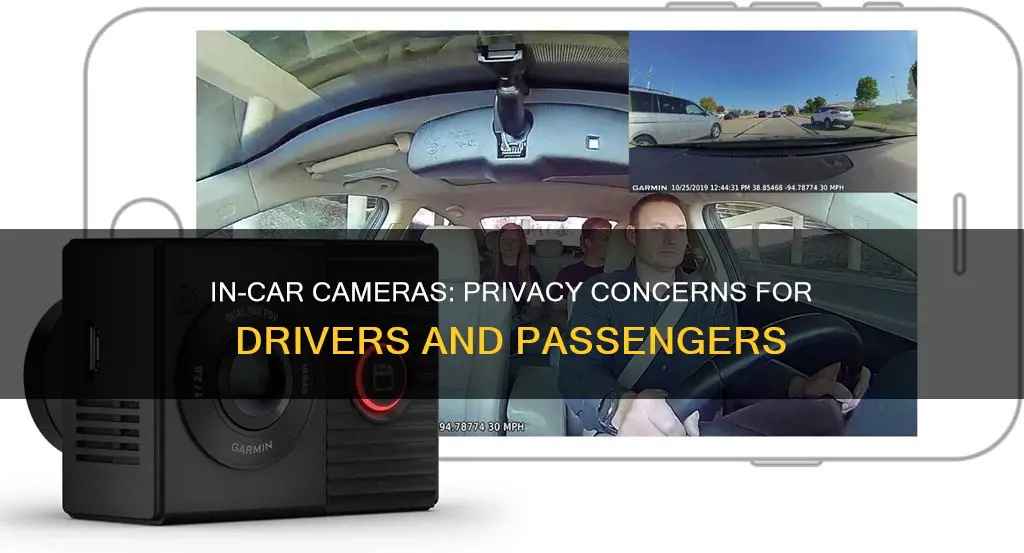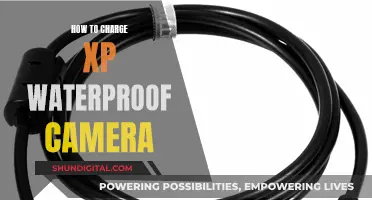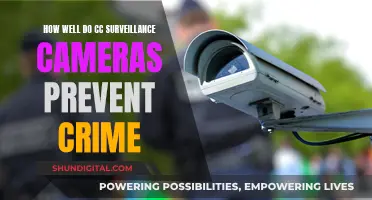
Cars are increasingly being fitted with cameras, both inside and outside the vehicle. This is partly due to the proliferation of driver-assist systems that require cameras to \see\ to operate properly, such as lane-departure assist and forward-collision warning. Additionally, some car manufacturers like Tesla and Volvo have started to put cameras inside cars for safety and protection. These cameras can be used to monitor the driver's awareness, detect drunk driving, and even determine the driver's mood or if they're intoxicated. While some people may view this as an invasion of privacy, others argue that it can improve vehicle security, safety, and convenience, especially with the rise of autonomous vehicles.
| Characteristics | Values |
|---|---|
| Purpose | Safety, security, convenience, data collection |
| Camera Locations | Inside, outside, steering column, rearview mirror, dashboard, rearview camera, mirror-mounted, ultrasonic sensors |
| Camera Functions | Monitor driver awareness, provide bird's eye view, facial recognition, detect proximity of objects, record footage, detect driver intoxication |
| Data Use | Developing autonomous driving, improving safety features, collecting data for manufacturers, insurance, law enforcement |
| Privacy Concerns | Data sharing with third parties, lack of transparency in privacy policies, potential for misuse of data |
What You'll Learn

Car cameras can be used to improve vehicle security
Another way that car cameras can improve security is by providing real-time alerts and notifications. Many modern car cameras have motion detection and sound detection features, which can send alerts to your phone if any suspicious activity is detected. This allows you to take immediate action, such as contacting the police or a security guard.
Car cameras can also be used to monitor your vehicle's surroundings, providing a clear view of everything happening around your car. This can be useful for detecting potential threats and taking preventive action. Some cameras even have object tracking capabilities, allowing them to automatically follow and record the movement of objects or people.
Furthermore, car cameras with night vision capabilities can provide round-the-clock surveillance, ensuring your vehicle is protected even when it's dark or parked overnight. This can significantly reduce the risk of theft or vandalism, which often occurs during these times.
When choosing a car security camera, it's important to consider factors such as power supply, internet connectivity, placement, and low-light performance. Battery-powered or solar-powered cameras can be a good option if you park in a public garage or an area without a power source. Additionally, look for cameras with 4G connectivity or a built-in SIM card, which can send footage and alerts directly to your phone, even without a WiFi connection.
In conclusion, car cameras are an effective tool for improving vehicle security. They can act as a visual deterrent, provide valuable evidence, offer real-time alerts, and monitor your vehicle's surroundings. With the right features and placement, you can significantly enhance the security of your car and reduce the risk of theft or vandalism.
Disputing DC Camera Tickets: What You Need to Know
You may want to see also

They can help propel cars towards an autonomous future
In recent years, drivers have been asking for hi-tech, onboard cameras, and car manufacturers have been listening. Indeed, cameras inside cars can help propel cars towards an autonomous future.
Cameras can be used to enable the vehicle to see what's around it, helping to reduce the window for human error, which is the leading cause of automotive accidents. For example, the 2020 Hyundai Sonata has five cameras installed throughout the car, four of which are used to provide the driver with an enhanced bird's-eye view of the vehicle's exterior.
Cameras can also be used for driver-assist systems, such as lane-departure assist and forward-collision warning, which can help to make driving safer. Some car manufacturers, like Tesla, are even using cameras for self-driving technology. Tesla uses eight cameras to give its vehicles 360 degrees of visibility, helping them to see the world around them.
In addition, cameras can be used to collect data about driving habits, which can be used by car manufacturers for future innovations like digital road maps that can aid autonomous driving. For example, BMW provides real-time vehicle data to the mapping software company HERE to develop a range of connected vehicle services.
While some people may have privacy concerns about the increasing number of cameras in cars, others see the safety benefits that this technology can bring. As advances in AI continue to be made, it is likely that we will see more and more cameras in cars, and these will play an increasingly important role in making driving safer and moving us towards an autonomous future.
Surveillance Cameras: Security, Safety, and Peace of Mind
You may want to see also

They can be used to monitor the driver's awareness
In-car cameras are increasingly being used to monitor drivers' awareness and alertness. These cameras, often placed on the dashboard or the steering column, use facial recognition technology to track the driver's head and eye movements, ensuring they are paying attention to the road and their surroundings. For example, the BMW X5 SUV has a driver monitoring camera to ensure the driver is focused on the road. Similarly, the Cadillac CT5 compact sedan has a camera that monitors the driver's awareness while using its hands-free driving assistant.
The Driver Monitoring System, or DMS, is a camera-based technology that identifies the driver and checks their level of vigilance. It alerts the driver when it detects signs of drowsiness or distraction, improving safety for the driver, passengers, and other road users. DMS technology is also being developed to go beyond monitoring just the driver's face. For instance, Gentex's latest DMS technology uses cameras and infrared emitters to monitor the entire car interior and its occupants. This system can even detect a child's respiration in a rear-facing car seat.
In-car cameras that monitor driver awareness are becoming more common, with some predicting that they will soon be mandatory in Europe. While these systems offer safety benefits, they also raise privacy concerns. For instance, a recent report by the Mozilla Foundation highlighted the potential for privacy violations with in-vehicle cameras, and legislation in California now requires dealers to inform consumers if a car has in-cabin cameras.
Bus Camera Tickets: Virginia's Issuance Protocol Explained
You may want to see also

They can be used to record evidence in the case of an accident
Car cameras can be used to record evidence in the case of a road accident. This evidence can be used to support personal injury claims and prove negligence. Video footage can provide an unbiased record of events, an accurate timeline, and visual details that human observers might miss or forget. These include traffic light colours, vehicle speeds, and road conditions.
Dashcams are widely available as aftermarket products, but some car manufacturers also offer built-in cameras. For example, the BMW Drive Recorder automatically saves a recording from 20 seconds before to 20 seconds after an impact. The Subaru EyeSight system uses two mirror-mounted cameras to guide the lane-keeping assist function and record what's happening around the vehicle on a 22-second loop, which is helpful in the event of an accident. The Toyota Dashcam system offers Parking Surveillance, which is activated if G-force sensors are jolted by an impact or even by someone leaning on the vehicle.
Some drivers opt to install their own dashcams. For example, a dual-channel dashcam can simultaneously record both the front and inside of the car at 1920x1080P@30fps, with infrared night vision. This footage can be used as evidence and for insurance claims during car accidents.
Protect Your Privacy: Cover Your Computer Camera and Monitor
You may want to see also

They can be used to collect data for city planning
Many modern cars are equipped with cameras and sensors that collect data about driving habits and road conditions. This data has a range of potential applications, from improving road safety and autonomous driving technology to influencing city planning, development, and policing decisions.
For example, Mobileye, a subsidiary of Intel, has access to a network of millions of sensors built into privately owned cars worldwide. While the primary purpose of these sensors is to power safety systems such as automatic emergency braking (AEB) and blind-spot warning (BSW), they also collect data on road conditions and traffic patterns. This data can be used to create detailed maps that identify areas where crashes occur frequently, where drivers tend to speed, and where infrastructure improvements are needed to enhance safety for cyclists and pedestrians.
Another company, Carmera, collects similar data from commercial vehicles and plans to expand its data collection to production vehicles from Toyota. They have also developed technology to blur the faces of bystanders in their camera footage, allowing them to count pedestrians and create granular block-level indexing scores to identify areas with high foot traffic. This data could be valuable for city planners and transportation departments in making informed decisions about infrastructure improvements and traffic management.
In addition to these private companies, municipalities themselves are also collecting and utilizing data from various sources, including micromobility services, sensors on municipal fleet vehicles, surveillance cameras, and smartphone apps. This data can be used to monitor and manage traffic flow, improve road safety, and inform city planning decisions.
While the collection and use of this data for city planning purposes offer significant benefits, there are also valid concerns about privacy and data protection. Some critics worry that data collected from cars could be used by insurers, landlords, credit reporting firms, and law enforcement agencies in ways that could negatively impact individuals or communities. As a result, it is essential to have robust data protection regulations in place to ensure that data is handled responsibly and ethically.
New Camera Battery Care: Do's and Don'ts
You may want to see also
Frequently asked questions
Yes, some cars have cameras inside. While it is more common for cars to have external cameras, some manufacturers, like Volvo and Subaru, have started to put cameras inside cars.
Cameras inside cars are usually used for safety and protection. Some cameras use AI technology to determine the driver's mood or if they are intoxicated. Other uses include facial recognition software to prevent drunk driving and enabling the vehicle to see what's around it, bringing it closer to an autonomous future.
Every car company is legally obligated to provide its privacy policies to all consumers, and they are usually easy to find on the company's website. You can also turn off the cameras or reset the car's database to protect your privacy.
Tesla, BMW, Volvo, Subaru, and General Motors are some of the car manufacturers that have been mentioned in this context.







